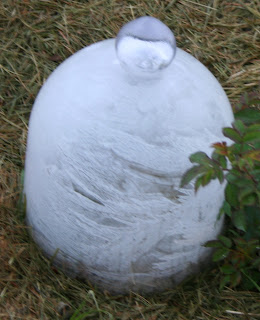In a recent post I recommended the use of boiled linseed oil for the annual care of wooden tool handles and in doing so, and making sure I was conveying correct information, I got quite an education on linseed oil. Here are ten facts about linseed oil that every gardener should know:
1. Linseed oil is actually flax seed oil. I always wondered what a "lin" plant looked like. Flax, I know. As an old man who hates burping the fish oil recommended by the doctor, and who has been taking flax oil (also high in the Omega-3 fatty acids) instead, I think it's important to know that I'm preserving my arteries with the same crap that dries sticky and yellow on my wooden handles. Now the question is, should I, as a frugal gardener, save money and just drink from the $5.00 linseed oil can instead of buying the bottles of gel-caps? Maybe the "do not take internally" text on the Linseed Oil can is a message in itself.
2. The particular characteristic of linseed oil that makes it useful for our purposes is that it is a "drying oil" (along with tung, soybean, safflower, and poppy) that polymerizes in combination with oxygen into a solid form. It also shrinks very little on hardening and penetrates wood well. It is a traditional finish for gun stocks, cricket bats, billiard cues, and surfboards.
3. In Europe cold-pressed linseed oil is eaten with potatoes and Quark cheese (a bland type of cheese). The "hearty taste" of linseed oil supposedly offsets the bland taste of the cheese. That means that a really terribly bland meal is made to taste like cardboard and is now considered edible.
4. Linseed oil is water-repelling, but not water resistant. Water penetrates a linseed oil finish in minutes and water vapour bypasses it completely. Garden furniture treated with linseed oil may develop mildew.
5. Linseed oil is a common carrier in paints, puttys and varnishes due to its drying properties. Okay, no surprise, everybody knows this one already.
6. Linseed oil was once used commonly to bind wood dust and cork particles into linoleum, a floor covering invented in 1860. The use of real linoleum has declined as more durable PVC floor coverings have been developed.
7. Linseed oil used to be boiled to cause it to begin polymerization and oxidation, thus making it thicker and shortening drying time. Today most "boiled linseed oil" products are a combination of raw linseed oil, petroleum-based solvents, and metallic/catalyst dryers. Modern boiled linseed oil is not edible, so stop chewing on the handles of your garden tools.
8. There was a National Linseed Oil Trust, formed in 1885 and based in St. Louis, that protected "linseed" interests in the United States. It was dissolved in 1920 under charges that it violated the Sherman Antitrust Act. As I read the history, essentially this was a linseed oil "cartel" that was accused of colluding to raise linseed oil prices.
9. The polymerization of Linseed oil is an exothermic reaction, which creates a cascade of heat buildup and make linseed oil-soaked rags particularly likely to cause spontaneous fires. Always. always spread these rags out to dry before disposal and never just throw them into a trash can wet.
10. The primary world producers of flax seed are Canada and China. The United States was fourth in production in 2007 and almost all of the crop is from North and South Dakota, Minnesota, and Montana.
So, that's the short story of linseed oil. Now that I know more about it, and have learned that it is one of the worst protectants of the natural oils against water, I probably need to choose something else to protect the handles of my garden tools. Tung oil, for example, is more resistant to water, doesn't yellow with age, and would be a much better choice as a protectant. But that brings up a whole bunch of other questions about using local versus imported substances (not many Tung nut trees are raised in the US) and the environmental effects of growing flax in mass quantities and on, and on. Being a world-conscious consumer is so exhausting.
 I noticed this weekend that I already had two of these delightful little fuzzy caterpillar nests in a young ornamental cherry tree. I tend to lump all these creepy, crawling little blights under the term "webworms", but a little research tells me that in my area, in the Spring and in a cherry tree, these are likely Eastern Tent Caterpillars (Malacosoma americanum). The real webworms, (Hyphantria cunea) occurs in the fall and are less discerning upon which trees they inflict. Of course, my invasion could be gypsy moths or Forest Tent Caterpillars, but to discern the differences, I'd have to let these barely visible white caterpillars mature a little bit, and I'm not about to do that. Odds being what they are, for the sake of simplicity, let us just call these Eastern Tent Caterpillars.
I noticed this weekend that I already had two of these delightful little fuzzy caterpillar nests in a young ornamental cherry tree. I tend to lump all these creepy, crawling little blights under the term "webworms", but a little research tells me that in my area, in the Spring and in a cherry tree, these are likely Eastern Tent Caterpillars (Malacosoma americanum). The real webworms, (Hyphantria cunea) occurs in the fall and are less discerning upon which trees they inflict. Of course, my invasion could be gypsy moths or Forest Tent Caterpillars, but to discern the differences, I'd have to let these barely visible white caterpillars mature a little bit, and I'm not about to do that. Odds being what they are, for the sake of simplicity, let us just call these Eastern Tent Caterpillars. 



























